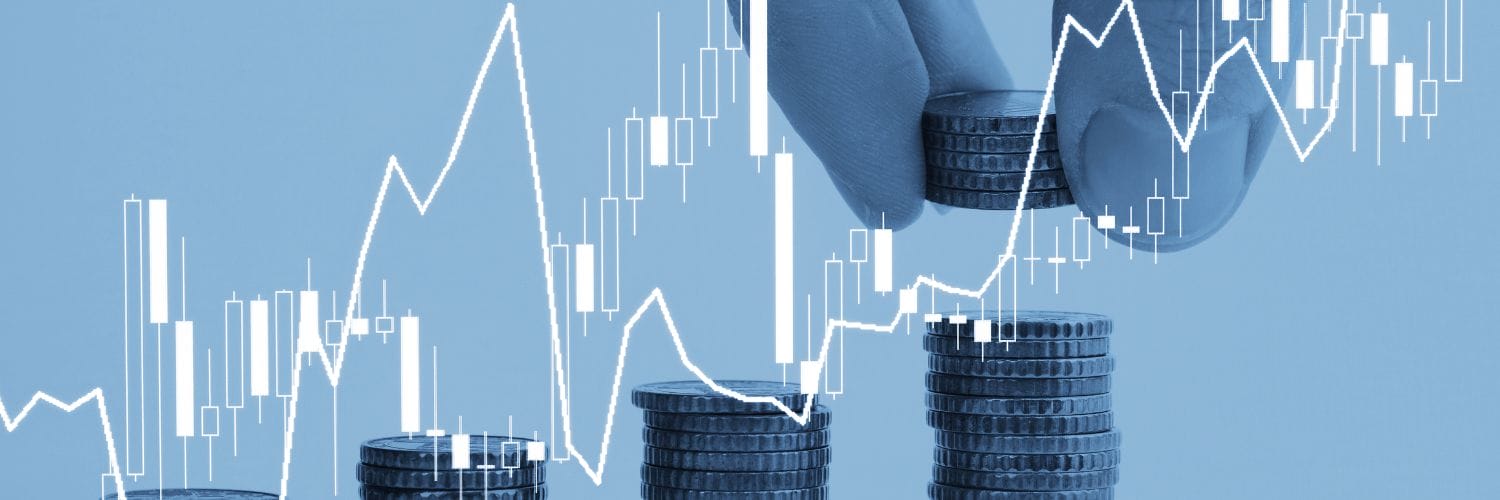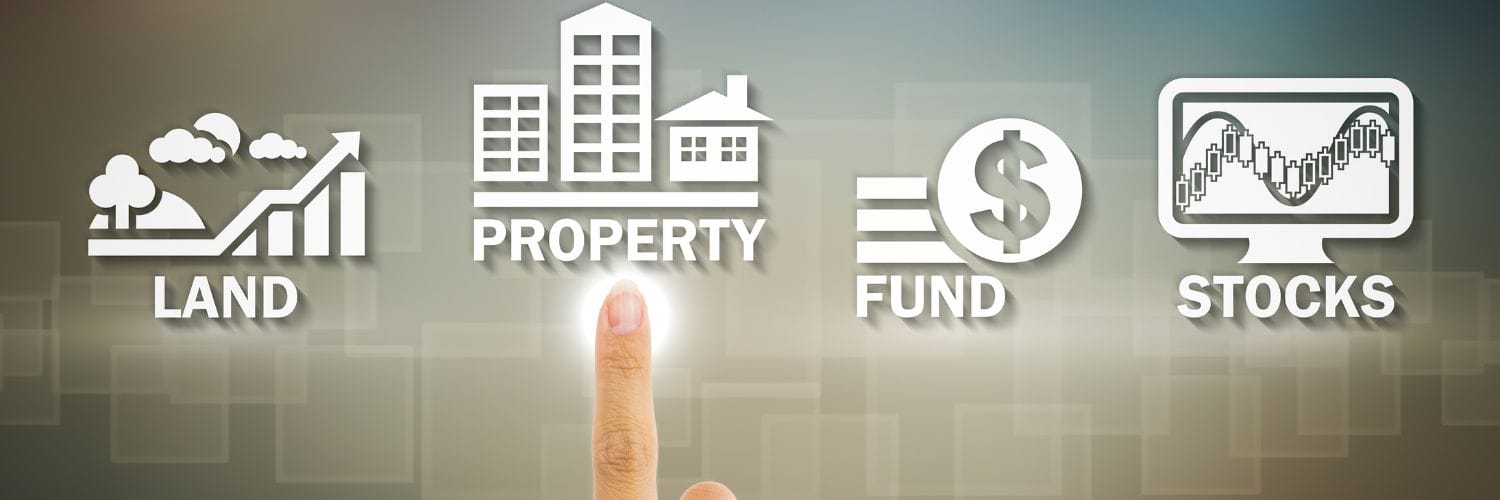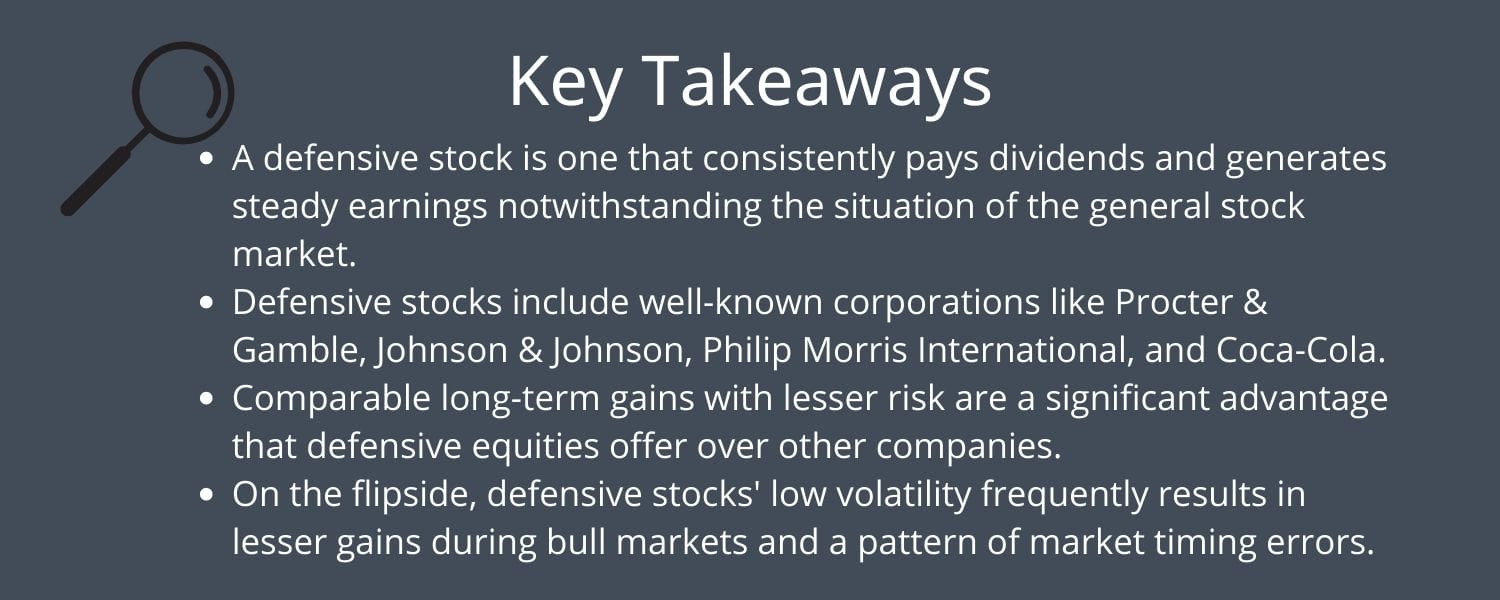“But investing isn’t about beating others at their game. It’s about controlling yourself at your own game.”
-Benjamin Graham
The majority of investors want to see their money increase in value. Growth is an important objective, but it’s not the only one. A prudent investment plan also protects a portfolio from economic downturns.
Defense-oriented equities perform as their name implies. They protect a portfolio of investments from losses. Defensive stocks consistently outperform other shares even during times of economic downturn, even though they don’t provide much in the way of growth potential.
Defensive stocks can shield your portfolio from significant value loss during a recession or bear market, acting as a barrier against erosion.
Benjamin Graham, Warren Buffett, and Charlie Munger, all-time greats, all talk about having conviction in your investments and buying companies with a margin of safety and moats.
They feel these types of investments have the chance to outperform the market over long periods, but also provide some protection against drawdowns or recessions.
Nothing in the investing world offers any certainty, but protecting against permanent losses remains as close as possible.
In today’s post, we will learn:
- What is a Defensive Stock?
- Understanding Defensive Stocks
- Pros and Cons of Defensive Stocks
- Examples of Defensive Investments
- How to Choose Defensive Stocks
- Investor Takeaway
Okay, let’s dive in and learn more about defensive stocks.
What is a Defensive Stock?
In times of economic uncertainty, defensive stocks often offer steady earnings and predictable returns.

Common examples of defensive stocks are the stocks of well-established businesses in the consumer goods, utilities, and healthcare industries.
Compared to their cyclical stock counterparts, these investments tend towards more resilience during recessions.
Defensive stock sectors are almost always in demand since they offer necessary goods and services. In contrast, cyclical stock performance is typically more susceptible to swings based on consumer demand and structural changes in the wider economy.
To remove any confusion, defensive stocks don’t refer to the defense industry, including companies like Lockheed Martin or General Dynamics. But confusion can set in because we could consider these companies defensive investments.
But in general, when discussing defensive stocks, we refer to companies with stable earnings, strong balance sheets, and the ability to survive or even thrive during a recession.
Understanding Defensive Stocks
Investors may increase their exposure to defensive companies to protect their portfolios during extreme volatility or economic weakness.
Defensive stocks include well-known corporations like:
- Procter & Gamble (PG)
- Johnson & Johnson (JNJ)
- Philip Morris International (PM)
- Coca-Cola (KO)
These businesses have robust cash flows and reliable operations that can withstand decreasing economic conditions. They also distribute dividends, which may act as a buffer for a stock’s price during a market downturn.
**Because of their superior resilience during downturns, defensive stocks remain less likely to declare bankruptcy.**
Why would anyone even want to purchase a stock if times are tough or unstable?
Why not just go for a Treasury bill’s safety, which essentially offers a risk-free return rate?
The answer remains straightforward: fear and greed drive market returns. Defensive stocks satisfy greed by providing a bigger possible dividend return in low-interest-rate circumstances. They also reduce anxiety because they remain less dangerous than normal stocks, and it typically takes a major disaster to destroy their business model.
Investors should understand that most investment managers need to purchase stocks. They will gravitate toward defensive stocks if they anticipate that conditions will remain more difficult than usual.
During recessions, defensive equities frequently outperform the market as a whole. However, they frequently do worse than the market while expanding.
Their low beta or market-related risk is to blame for that. Betas below one are typical for defensive equities.
Take a look at a stock with a beta of 0.5 to demonstrate beta. We anticipate the stock losing only roughly 1% if the market drops 2% in a given week. On the other hand, the defensive stock with a beta of 0.5 might anticipate improvement by just 1% following a week of market price growth of 2%.
Pros and Cons of Defensive Stocks
Let’s take the positive side of the equation first.

Defensive stock investing can often be less dangerous than cyclical stock investing. Any form of investing carries risk, including the potential for financial loss. On the other hand, defensive stocks are less likely to experience a value decline during a stock market downturn or a recession because their products and services remain continually in demand.
Predictability offers another benefit of defensive equities’ low volatility. Defensive stock returns offer modest and consistent returns and dividend payments, if the company pays them, making it possible to estimate the growth of your investments over time. It can sound enticing if you’re saving for retirement or trying to reach a certain financial goal.
Now, let’s take the con side of the equation.
On the flip side, defensive stocks’ low volatility frequently results in lesser gains during bull markets and a pattern of market timing errors.
Unfortunately, many investors give up on defensive equities late in a bull market, when they most need them, because of underperformance.
After a market downturn, investors occasionally invest quickly in defensive equities, but many times, it’s already too late. The rate of return for investors might be significantly reduced by these unsuccessful attempts to time the market with defensive equities.
Examples of Defensive Investments
First things first: what distinguishes a business from industry from a sector? Companies are the smallest units of the economy that each term describes. An industry consists of a group of businesses and sectors made up of industries. The US stock market comprises eleven sectors, but the following remain the key protective sectors:
- Utilities
- Consumer staples
- Healthcare
Consider purchasing stock in businesses with a proven track record of success in these industries if you’re trying to invest in defensive stocks.
Companies in these industries provide the items and services that people constantly and consistently need to meet their basic needs.
Consumers may cut their budgets during a recession, but unless necessary, they are unlikely to cease paying their power bills, buying groceries, or filling their prescriptions.

Defensive stocks often have low volatility, stable earnings, and steady dividends through market ups and downs because consumer demand is constant; this explains why these stocks sustain moderate growth even in an expanding economy.
Utilities Sector
The electric, gas, and water utilities, as well as businesses that function as distributors or producers of those utilities, are all included in the utility sector. Also included are renewable energy sources like solar and wind power.
Consumer spending on utilities is less likely to decrease even during a recession, so the value of equities in this industry tends to be steady.
Several examples from the utility sector:
NextEra Energy (NEE)
- Current market cap = $149.3 billion
- Current market price = $74.34
Consolidated Energy (ED)
- Current market cap = $28.9 billion
- Current market price = $81.04
Consumer Staples
Because consumers are unlikely or unable to eliminate these expenses from their budgets, regardless of their financial status, companies in the consumer staples sector are frequently less susceptible to significant economic fluctuations.
The consumer staples industry includes businesses that produce or sell food, drinks, tobacco products, personal care, hygiene, and non-durable domestic goods.
Equities in consumer staples typically remain stable when consumers cut back on their spending during a recession, unlike stocks in the consumer discretionary sector, which includes businesses like hotels and car manufacturers.
Great examples from the consumer stables include:
Proctor & Gamble (PG)
- Current market price = $125.06
- Current market cap = $296.3 billion
Walmart (WMT)
- Current market price = $133.10
- Current market cap = $360 billion
Costco (COST)
- Current market price = $473.90
- Current market cap = $208.9 billion
Healthcare Sector
Businesses that offer medical services and insurance, produce medical supplies or medications, or assist patient care in hospitals, clinics, labs, and nursing homes are all included in the healthcare sector.

Healthcare is a necessity, and there is always a need for drugs and medical supplies; thus, this industry presents excellent defensive investment prospects.
Great examples from this sector include:
CVS (CVS)
- Current market price = $88.99
- Current market cap = $116.1 billion
Elevance Health (ELV)
- Current market price = $482.58
- Current market cap = $112.9 billion
Telecom
Consumers will always need telecommunications services, including cable, phone, and internet providers. In tough times, they might scale back or downgrade, but these companies’ revenues are often quite consistent.
Wonderful examples from this sector include:
Verizon (VZ)
- Current market price = $36.16
- Current market cap = $150.9 billion
Charter Communications (CHTR)
- Current market price = $307.32
- Current market cap = $49.3 billion
Real Estate (Apartment REITs)
Given that people will always require housing, apartment real estate investment trusts (REITs) represent good defensive investments.
Avoid REITs that concentrate on ultra-high-end apartments when seeking defensive investments. Avoid office building REITs and industrial park REITs as well, as they may experience an increase in lease defaults when business is sluggish.
A great example from this sector includes:
Mid-America Apartment Communities (MAA)
- Current market price = $145.11
- Current market cap = $16.9 billion
How to Choose Defensive Stocks
To invest well over a long period, we need to have rules or principles we can rely on during rough times, such as a recession.

These ideas originated from Benjamin Graham and were adopted by the greats, including Warren Buffett and Charlie Munger, among many others.
Let’s create a sample list to get you started:
- Margin of safety
- Expect volatility and take advantage of it
- Understand what kind of investor you are
Margin of Safety
The margin of safety is the idea of purchasing the security at a substantial discount to its true value, which is supposed to offer the potential for large returns while simultaneously lowering negative risk.
Simply put, Graham’s objective was to acquire assets valued at $1 for 50 cents. He did this quite effectively.
These commercial assets may have been significant to Graham due to their consistent earning capacity or liquid monetary value.
For instance, it was customary for Graham to invest in stocks where the liquid assets on the balance sheet (net of all debt) exceeded the company’s full market valuation (also known as “net nets” to Graham’s followers). This implies that Graham was practically acquiring companies for free. Graham had various other financial ideas, but this was his go-to approach.
This idea is crucial for investors to understand since value investing can result in significant returns once the market, which will inevitably re-evaluate the company and increase its price to fair value, does so.
If things don’t go as planned and the business fails, it also offers protection on the downside. The key to Graham’s success was the safety net of buying the underlying company for a lot less than its fair value.
When carefully chosen, Graham discovered that further declines in these inexpensive equities were rare.
Although many of Graham’s pupils successfully utilized their methods, they all had a common understanding of the “margin of safety.”
Expect Volatility and Take Advantage of It
Trading stocks entails adjusting to volatility. Market downturns are opportunities to locate unique assets, not times to flee, according to the wise investor.
Graham used the metaphor of “Mr. Market,” the fictitious business partner of every investor, to explain this point.
Mr. Market provides a daily price quote for investors at which he would either buy out an investment or sell his ownership stake in the company.
He occasionally offers a high price since he is enthusiastic about the company’s potential. Other times, he offers a low price because he is discouraged about the company’s future.
Dollar cost averaging offers one of the ways we can take advantage of volatility by regularly purchasing investments in equal dollar quantities.
It uses price declines and eliminates the need for an investor to worry about acquiring a sizeable position at the market’s peak. For passive investors, dollar cost averaging is beneficial since it relieves them of deciding when and how much to purchase their investments.
Understand What Kind of Investor You Are
Graham used the terms “enterprising investors” and “defensive investors” to describe both active and passive investors.
There are only really two options available to you. The first is to devote a significant amount of time and effort to learn to invest wisely and to associate the caliber and quantity of in-depth study with the anticipated return.
If this isn’t your cup of tea, be happy with a passive (potentially lower) return that requires significantly less time and effort.
Graham turned the academic axiom “risk = return” on its head. Work meant a return to him. Your return should increase as you invest more and put more effort into your investing.
Investing in an index is an excellent choice if you lack the time or the desire to conduct thorough research on your assets. By just purchasing the 30 equities that make up the Dow Jones Industrial Average in equal amounts, according to Graham, the conservative investor may get an average return.
According to Graham and Buffett, getting even an average return, like the S&P 500, is more of an accomplishment than it might appear.
According to Graham, the misconception many individuals fall prey to is that since it’s so simple to obtain an average return with little to no effort (via indexing), a little bit more effort should result in a somewhat greater return. In actuality, most of those who attempt this perform much below average.
The defensive investor of today would invest in index funds that include both stocks and bonds.
They control the entire market, profiting from the strongest regions without attempting to foresee them in advance. By letting the stock market’s general performance determine long-term returns, an investor is assured of the market return and avoids performing lower than average.
Beating the market is far easier said than done, and many investors find it difficult to do so, according to Graham.
Investor Takeaway
As we go through rough times, having a plan, finding good companies, and remaining disciplined can help us reduce our losses.
Investing in individual companies offers many benefits but also some negatives. For example, holding Amazon during the dot-com bust, when it fell 90%, would have felt like the end of the world.
And Buffett mentions many times, he has endured many drawdowns of 50% or more during his time with Berkshire.
But defensive stocks can help weather these storms, and using these types of companies to help smooth out your returns offers a great way to build a portfolio.
Yes, many remain far from exciting, but would you rather hold the most exciting stocks and lose money or have a basket of companies you love and more defensive stocks?
And with that, we will wrap up our discussion for today.
Thank you for reading today’s post; I hope you find something of value. If I can be of any further assistance, please don’t hesitate to reach out.
Until next time, take care and be safe out there,
Dave
Related posts:
- Historical Economic Data: 25+ Years (U.S.) Updated – 11/17/23 It’s hard to understand the economy in general because there’s so much data, and it’s so often taken out of context. We...
- 9 Industries That Thrive During a Recession Today’s economy operates differently from past recessions. The Great Depression, for example, hit at a time when the primary means of transportation were trains and...
- The Importance of Price Elasticity of Demand in Investing “The single most important decision in evaluating a business is pricing power. If you’ve got the power to raise prices without losing business to a...
- Common Indicators of Rising Interest Rates and Its Impact on the Economy How can you tell when interest rates might rise and what the impact would be on our lives? You can use simple tools to answer...

